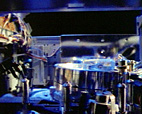|
|
Fixing the problems technology has caused Although technology has contributed to environmental problems, many people argue that those problems can be fixed by applying more technology. Sometimes, however, technological solutions cause other problems&emdash;as was pointed out by the ESD working group on manufacturing: "A target for improving the efficiency of the combustion of fossil fuels is to convert all available carbon in the fuel into carbon dioxide. On the other hand, carbon dioxide is a major greenhouse gas. Moreover, our means of achieving better thermal efficiencies is by increasing the temperature of the combustion process. A result of increasing temperature, however, is that more oxides of nitrogen are formed from the air used in combustion. Oxides of nitrogen are an important element in the formation of photochemical smog. Thus, in the pursuit of more efficient energy usage, it is possible other potentially undesirable side-effects may arise." (ESD Working Groups 1991, p. 24) Jacques Ellul, a well-known French commentator on technology, argued as far back as 1964 that societies do not have much choice when it comes to the technologies they will use&emdash;because technologies tend to build upon themselves. Technologies create problems that in turn have to be fixed by new technologies. He gives the example of large cities that require technologies to cope with the concentration of people. Those technologies permit the cities to grow even further; and some, such as garbage-disposal units, create new pollution problems: "The present level of technique brings on new advances, and these in turn add to existing technical difficulties and technical problems, which demand further advances still." (p. 92) Barry Commoner does not accept the view that technology is beyond human control and that it has a momentum of its own. He argues that the spiral of technical fixes occurs because of the failure to correct the fundamental flaw that technology is subject to in our society. He says that 'if technology is indeed to blame for the environmental crisis, it might be wise to discover wherein its "inventive genius" has failed us&emdash;and to correct that flaw&emdash;before entrusting our future survival to technology's faith in itself' (1972, p. 179). A common reaction to the litany of problems attributed to technologies is to argue that the problem is not so much in the technology but in how it is used or abused. Technologies themselves only become environmentally harmful if they are not applied with due sensitivity to the environment. Another reaction is to argue that technologies often have unexpected side-effects or second-order consequences that were not originally designed into the technology. Pollution is one such side-effect that is never intended by the designers of technology. However, Commoner does not accept these views, arguing that: 'These pollution problems arise not out of some minor inadequacies in the new technologies, but because of their very success in accomplishing their designed aims' (p. 183). Commoner points out that plastics do not degrade in the environment because they were designed to be persistent; similarly, fertilisers were designed to add nitrogen to the soil, so it is not an accident that they add to the nitrogen reaching the waterways. Part of the problem, he argues, is that technologists make their aims too narrow; they seldom aim to protect the environment. He argues that technology can be successful in the ecosystem 'if its aims are directed toward the system as a whole rather than at some apparently accessible part' (p. 186). He gives sewerage technology as an example. He says that engineers designed their technology to overcome a specific problem: when raw sewage is dumped into rivers, it uses up too much of the river's oxygen supply as it decomposes. Modern secondary sewage treatment is designed to reduce the oxygen demand of the sewage. However, the treated sewage still contains nutrients which help algae to bloom; and when the algae die they also deplete the river of oxygen. Instead of this piecemeal solution, Commoner argues, engineers should look at the natural cycle and reincorporate the sewage into that cycle by returning it to the soil rather than putting it into the nearest waterway. Commoner advocates a new type of technology that is designed with a full knowledge of ecology and the desire to fit with natural systems.
|

 Technological
Change
Technological
Change